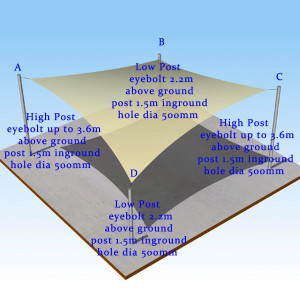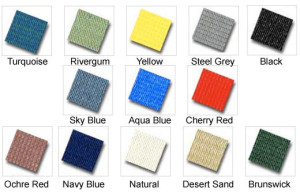
Hypar Design Shade sails
Probably the most common design for shade sails in the industry is the standard “Hypar” Design. Hypar is short for hyperbolic parabola. This basically means twisting the sail to create a 3D effect. Typically when people look at a hypar shadesail for the first time they often mistakenly think that it is two triangles when in fact it is a single piece of fabric tensioned in such a way as to create this interesting architectural effect.
The hypar effect is created simply by installing diagonally opposed high and low attachment points. This then creates the 3D twist effect in the sail.
Installing a hypar design shadesail starts by working out the two low points. Usually the low points of the sail are 2.2 metres above ground. Where ever possible look to install at least one of the low points in the direction you want the shade to cast. For instance, if you want shade later in the afternoon then consider fitting one of the low points toward the west. That way you create a lower edge to the sail limiting the amount of sun which can cut in under it and maximising your usable shade.
There’s a simple formula for working out the twist in the sail. Let’s say you want to create a relatively gentle twist in your sail, nothing to dramatic. To do this you work measure the longest side of the sail and then times it by 15%. For example, lets say the longest edge to your shade sail was 6 metres. 15% of 6m = 900mm. If your low points of attachment were 2.2 metres then you’d want the high points of attachment to be 3.1 metres above ground (i.e: 2.2 + .9 = 3.1). If you want to create more dramatic effect, then increase the percentage of variance, say up to 20%.
Hypar shade sails are an industry standard because they work. They give good amounts of usable shade, they look great and they tension up easily. They don’t need to be limited to 4 points of attachment but can be 6, 8 or more. I’d say if your thinking about installing a shade sail then you should be thinking about how a hypar design can work for you.
Choosing The Right Shade Cloth
Not all shade cloth is made equal and when you are choosing someone to make your new shade sail you should really look carefully the brand

Synthesis Commercial 95
and the UV Rating of the fabric they intend to use. Over the years we have experimented with lots of different fabrics and most have performed well however, we’ve tended to stick with a Commercial 95 which is made by the Australian company Gale Pacific. C95 has in recent years been rebranded as “Synthesis Commercial 95″. What we like about it most is that it give very high UV block – up to 98% and has a low stretch properties making it ideal for medium-sized tension applications. It comes in a wide range of colours and like all commercial shade cloths today, has a 10 Yr pro rata warranty against UV degradation.
One thing about C95 is that it is a tape /monofilament cloth which means that it is knitted with monofilament (which is similar to fishing line) and to get the UV block, take is knitted into the fabric. Some people believe that tape shade cloths should not be put under tension and to a degree this is true. The reason is that the tape can stretch causing the sail to sag over time. C95 however retains its anti stretch properties through its monofiliment construction. There are other fabrics on the market which stretch more and aren’t suited to tension applications. Typically these are referred to as ‘domestic’ shade cloths.
One thing that is important to mention here is that there are some shade cloths on the market which are 100% monofiliment – that is, they have no tape filler, all the shade is created by knitting the monofiliment. What I have seen over the years is that although this style of fabric is incredibly strong and well suited to large shade sail applications such as covering car parks, it lacks UV block and having sat underneath shade cloth with only a 90% UV block on hot days, you get the feeling that something is lacking.
In summary, when selecting the shade cloth to have your sail made from, it will serve you well to be educated. In the book DIY Shade, I list most of the major brands of shade cloth and their various UV ratings and other important characteristics. Being educated on this subject can really make a difference between getting a sail that keeps you and the family cool and UV safe on hot days and not.
Happy Shade sailing.






